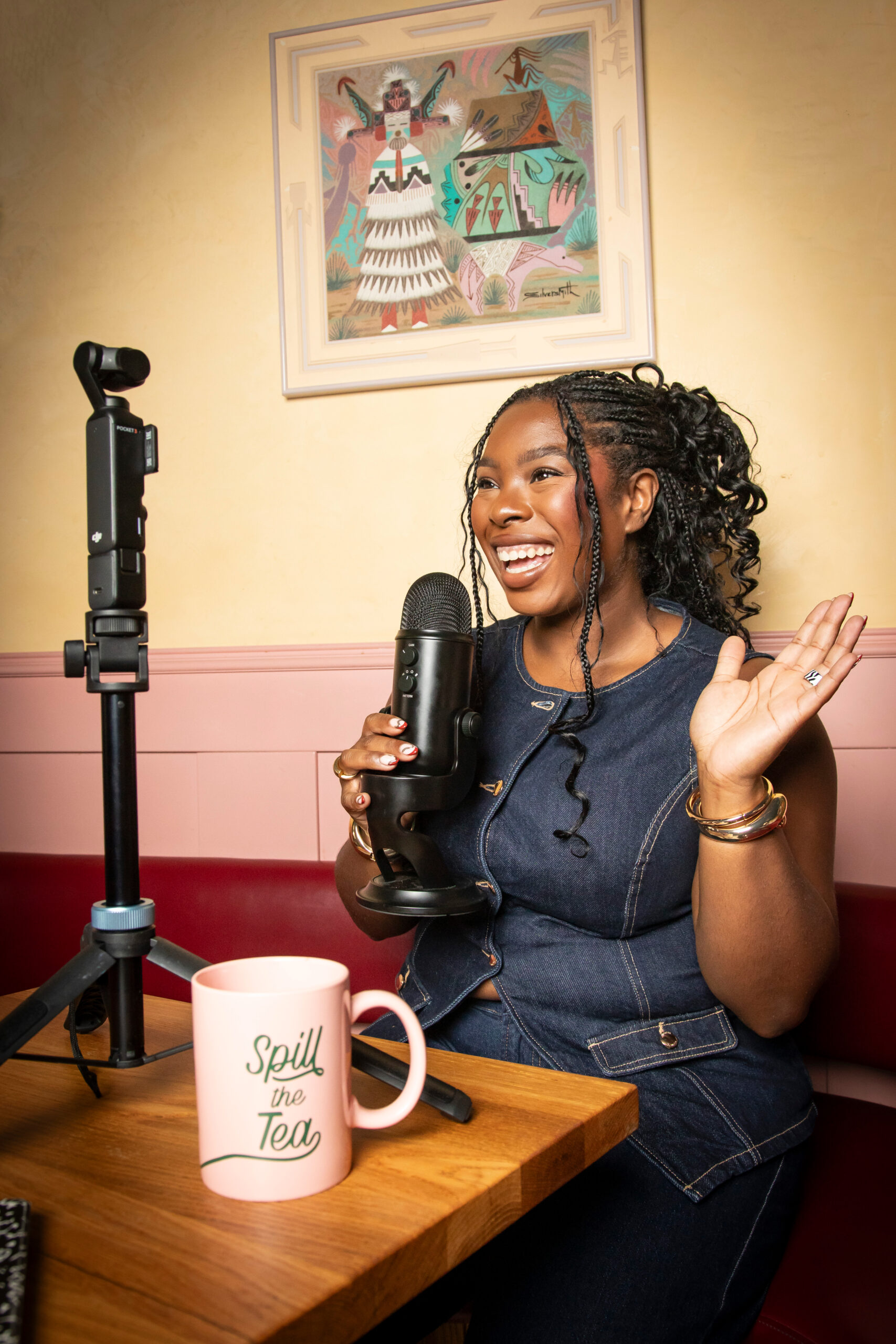HEY FRIEND!
I'm jemilla!
In the past 4 years, I’ve cut my teeth strategizing & writing award-worthy, revenue-increasing, results-snatching copy. And what really lights my fire is writing for woman-owned and BIPOC-led brands. I’m talkin’ the first day after a braiding appointment type of excited! Energizing them to go big with their bold ideas so that when launch time happens, the world thinks “OMG FINALLY, I’ve been waiting for something like this.” And giving them the tools to diversify the market.
about me
services
Email Marketing for Small Businesses: How to Get Started
September 5, 2024
Email marketing for small businesses is a great form of content marketing that has an average ROI of up to $40 for every $1 spent. And with 4.48 billion email users worldwide, you have a big audience to work with (after niching down to your ideal client, of course).
Email marketing is 100% owned by you, so you don’t have to worry about a random social media blackout messing with your content plan. Subscribers are more likely to convert than social media followers because they’re more dedicated — in fact, people are 3x more likely to make purchases from email marketing than social media.
They put enough trust in you to give you their name and email address, and expect insane value in return.
And that’s really what an email newsletter is all about: giving insane value to your subscribers they wouldn’t get anywhere else, and priming them so that when it’s time to promote or sell your product or service, they’ll think it’s a no-brainer to invest because of how much you’ve already given them for free.
But you might have a few questions about:
- How to start email marketing for your small business
- Which email marketing platform to invest in
- How often to send emails, and when
- What to say in your emails
- Other email marketing tips
I’m going to get into all of it in this blog post. Let’s go ⬇️
How to start email marketing for your small business
First things first, you should ask yourself what someone would get from subscribing to your newsletter that they wouldn’t get from following you on social media, or reading your blog.
I, for example, always send my subscribers branding advice, copywriting tips, and marketing news every week that they don’t get on social media (or don’t get the full picture of).
So figure that out first. Then, you have to get them on to your email newsletter! You can try to just have an opt-in form but let’s be real, no one wants to give something without getting something first. We’re selfish creatures, it’s just facts!
So, you can create a lead magnet — a free resource — that they can download, which puts them onto your email list.
A lead magnet can be a can be a checklist, swipe file of templates, content ideas, trial subscriptions, samples, free consultations, and more. Some of my lead magnets include a resource of 115 call-to-action and call-to-value options, a resource of 21 creative copywriting techniques, and a brand voice guide workbook and Canva template.
Once they subscribe to get your lead magnet you have to, you know, GIVE IT TO THEM. But you don’t want just to deliver the lead magnet and dip.
You can have an automated welcome sequence — a series of 4 to 8 emails that delivers your lead magnet to your subscriber, tells them what they can expect being on your email list, tells them a little bit more about yourself, gives some more free value, and maybe promotes one of your offers. And, lest we forget, give them the option to unsubscribe. You don’t want to make them feel like a hostage!
I created a customizable welcome sequence template with 9 emails for this very reason, so you can check all these boxes while also maintaining your brand voice.
Now, in order to actually have an automated welcome sequence and start sending emails to your subscribers, you need to choose an email marketing platform, which I’ll get into next.
Email marketing platforms
There are several platforms to choose from with email marketing for small businesses in the online community trust and prefer using:
- Mailchimp
- Flodesk
- ConvertKit
- MailerLite
- ActiveCampaign, and more
I’m going to share some basic information on just these email marketing platforms — but I’ll dive deeper into them, and others, in another blog post!
Mailchimp
Over 11 million people use Mailchimp globally, and they have a reputation of getting them up to 25x ROI and $1.7k per campaign on average. You can try their Standard plan free for one month, and then it’s CAD $27.16/month. This gives you:
- 500 contacts
- Generative AI features
- Advanced segmentation & reporting
- Enhanced automations
- Custom-coded email templates
- Data-driven optimization tools
- Personalized onboarding

Mailchimp also recommends ways for you to get more opens, clicks, and sales. This is a great platform to start email marketing for small businesses, and when you start to approach the 500 subscriber mark, you can upgrade to a higher paid plan or another platform.
Flodesk
Flodesk is great for creating gorgeous emails, its user-friendly templates and design, and seamless automations and app integrations. You can also create stunning, signup-worthy forms and landing pages. And it seamlessly integrates with your Stripe account, so you can easily get paid when someone buys your product from your Flodesk Checkout page.

Their email plan is $35/month ($59/month to also have Checkouts), and includes:
- Unlimited subscribers
- Audience segmentation
- World-class templates
- Custom fonts
- Personalized links
- Custom domains
- Link in bio
- Pop-up, Embedded, and hosted forms
- Landing pages
- Unlimited emails
- Custom layouts, and more
ConvertKit
ConvertKit is a creator marketing platform built by creators with email marketing capabilities, marketing automations and integrations, and you can sell digital products and integrate additional platforms for sales insights.
If you want the simplest plan on ConvertKit, it’s $0/month for up to 10,000 subscribers and:
- Unlimited landing pages, opt-in forms, and email broadcasts
- Audience tagging & segmentation
- You can sell digital products
- You can run paid newsletters & subscriptions, and more

Their paid plans come with a lot more, and are better suited for growing creators automating their work and established creators scaling their business.
MailerLite
MailerLite’s advanced email marketing features lets you collect subscribers, automate workflows, and monetize your audience of 1,000 for just $0/month:
- Drag & drop editor
- 12,000 monthly emails
- Email automation builder
- Websites
- 10 landing pages
- Comparative reporting
- Signup forms & pop-ups, and more
When you get more subscribers, the price bumps up and gives you more plan features — like the ability to sell digital products, unlimited monthly emails, AI writing assistant, and more.
ActiveCampaign
ActiveCampaign’s main message is all about effortless email & marketing automation, and AI-powered automations that suggest, personalize, and validate your marketing campaigns to help you grow your business.

You get a free 14-day trial to:
- 1,000 subscribers
- 250+ pre-made templates
- Advanced segmentation
- SMS marketing and ads
- Sales engagement automation and CRM tools
- Integrations with apps like Shopify, Stripe, Squarespace, Salesforce, Google Ads, Instagram, Zapier and more
After your 2-week trial is up, their Starter plan is $20/month!
When & how often to send emails
The biggest thing when it comes to email marketing is consistency. The worst thing is to be hot and cold with your subscribers, sending them 3 emails when you want to sell something and then ghosting them for months.
If this is something you’re guilty of, don’t worry, we’re going to fix that!
Ask yourself how often you think you can send emails. What is feasible for you? Apparently sending emails 2-3 a week is ideal — but I know one a week is my limit because any more and I’ll be stretching myself too thin, and that’s okay!
If you can only fit bi-weekly emails into your schedule, or one email a month, that’s fine. Start with what you’re capable of, and then try and up your frequency after a year or two of consistency — and notify your subscribers of this change so they won’t be surprised.
According to Forbes, the most popular time to send an email marketing campaign is Tuesday at 12 p.m, but open rates are higher on Saturdays at 37.6%.
I personally send emails on Tuesday mornings — but if you want to stand out and not get lost amongst all the other emails your target audience might be getting on Tuesdays at noon, you can send them on Saturdays instead, when open rates are higher.
What to say in your emails
That’s the age old question, isn’t it? Email marketing for small businesses is talked about more than creating Canva lead magnets, but knowing what to say in these emails always trips people up.
And with 61% of consumers spending an average of only 8 seconds viewing an email, you really have to hook them and get them to stick around for longer! So, here are a few things you can say in your emails ⬇️
Industry statistics, facts, and news
→ This will help your subscribers stay on top of important information that can keep them ahead of the curve.
Examples:
- 49 Email Marketing Statistics In 2024
- The Best Paris 2024 Olympics and Paralympics Ads: Coca-Cola, Microsoft and Nike Go for Gold
- It’s Going to Be a Creator Commerce Holiday
Tips, tricks, and how-tos
→ These kinds of emails will be great free value for your subscribers who may be DIYers, a virtual assistant that needs to do all the things for their boss, or for anyone trying to get into your field
Examples:
- 5 Must-Have Traits for Magnetic Copy
- How to Create A Figma Wireframe
- 7 Zapier Integrations That’ll Make Your Workday Simpler
Resources & education
→ This will also be great for the DIYer, VA, and aspiring pro that wants to brush up with other forms of education
Examples:
- 10 Copywriting Books To Add to Your TBR
- 7 Websites Every Social Media Strategist Should Bookmark
Case studies & testimonials from your client projects
→ These are promotional emails that will not only promote your products and/or services, but will also be a great credibility booster that proves you’re good at what you do
Examples:
- What Sara, Xander, and Teagan are saying about the HydraPlump Lip Gloss
- Brand Relaunch Case Study: Podcast Media Agency Atabey & Co.
Life updates
→ If you’re more of a personal brand or want to connect to your subscribers beyond delivering value and promoting your offers, sharing a sneak peek into your 5-9 life is a great way of doing that. You can also seamlessly integrate personal stories into every email and build it as a segue into whatever value you’re giving them in that email!
Example:
- Thrifitng outfits is my entire personality, and so is reading industry reports → The biggest takeaways I got from AWAI’s 2024 State of the Industry Copywriting Report
Email marketing tips
There are a lot of statistics out there about email marketing for million-dollar corporations, and these can also be applied to email marketing for small businesses. Here are some tips:
- Personalization and segmentation
- Open a loop in the first sentence
- Optimize for mobile
- Have automated email flows for abandoned carts and post-purchase
- Gamify emails
Personalization and segmentation
People like to feel like they’re special — we know this, but it’s also true factually:
- Personalization within emails generates 6x higher transaction rates
- Adding an email recipient’s first name to the subject line of an email can increase open rates by 9.1%
- 80% of people are more likely to make a purchase from a personalized email
Most email marketing platforms will have tech that makes segmentation easy, but you can further personalize emails with insight from consumer surveys and polls that tell you what musicians your subscribers listen to, places they like to shop, pop culture events they’re tapped into, etc.
Open a loop in the first sentence
People engage with emails for 2-8 seconds only 23.5% of the time, and 15% of emails are looked at for less than 2 seconds. So, if you want them to actually read your email in entirety, you want to engage them in the first sentence.
Opening a loop is a great way of doing that. You start a story but don’t give a satisfactory ending, so they have no choice to keep reading.
Like “Are you tired of spending hours creating content without seeing results?” or “Who knew I’d double my booking rate with this one small addition?” These kind of openers imply that you’re going to reveal a solution, a secret, or a fix to their problem. So instead of staying engaged for a short period of time, they scroll to the bottom and read the entire email!
Optimize for mobile
41% of email views come from mobile devices, so you’ll want your email to be optimized for cell phones and tablets and not just desktop. Again, email marketing platforms have you covered here, as most of them can preview your email in different device views so you can edit it for optimal conversions!
Automated email flows for abandoned carts and post-purchase
Abandoned cart emails are what you send after a potential customer added a product to their cart and decided not to through with it. And post-purchase emails are when they do buy the product, and you want to keep that relationship going.
Abandoned cart, post-purchase emails, and other automated flows generate up to 30x more revenue per subscriber, and the average abandoned cart email open rate is 50.5%.
So, if you sell products online and want to increase your chances of revenue, include automated abandoned cart and post-purchase email flows in your marketing funnel. Again, most of the email marketing platforms mentioned above make this easy!
Gamify emails
“Gamification’ is the latest buzzword in the advertising world. Apps like Duolingo and Starbucks implement this really well, rewarding continued streaks when learning a new language or offering rewards points for frequent purchases. And according to Forbes, gamifying emails can increase your ROI by 300%.
So, try gamifying your own emails! You can create contests with all sorts of prizes when subscribers participate, or even have a rewards-based system when subscribers reply or share an email.
In conclusion
This was a doozy of a post, wasn’t it? But it should be a great guide to email marketing for small businesses. You can grab my welcome sequence template to get started — it’s great for service-based and product-based businesses, are easy to customize, and come with Flodesk shared templates so you can start email marketing on one of the internet’s most favourite platforms!






